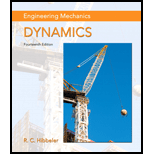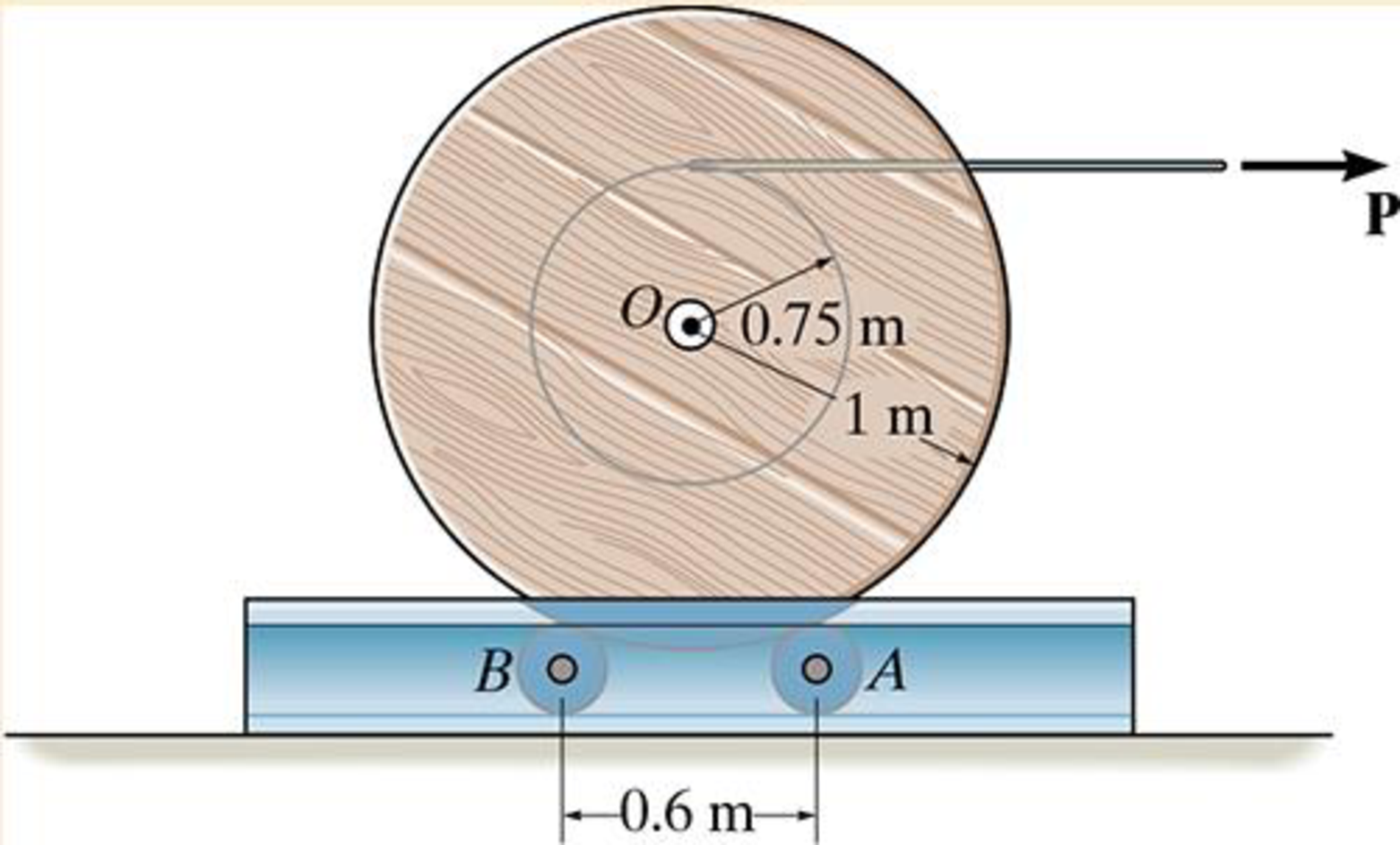
Engineering Mechanics: Dynamics (14th Edition)
14th Edition
ISBN: 9780133915389
Author: Russell C. Hibbeler
Publisher: PEARSON
expand_more
expand_more
format_list_bulleted
Concept explainers
Textbook Question
Chapter 18.4, Problem 4P
Determine the angular velocity of the reel after it has made two revolutions starting from rest. Neglect the mass of the rollers and the mass of the cable. Assume the radius of gyration of the reel about its center axis remains constant at ko = 0.6 m.

Expert Solution & Answer
Want to see the full answer?
Check out a sample textbook solution
Students have asked these similar questions
this is an old practice exam, the answer is Ax = -4, Ay = -12,Az = 32.5, Bx= 34, Bz = 5, By = 0 but how?
This is an old practice exam, the answer is Ax = Az = 0, Ay = 2000, TDE = 4750, Cx = 2000, Cy = 2000, Cz = -800 but how?
this is an old practice exam, the answer is Fmin = 290.5lb but how
Chapter 18 Solutions
Engineering Mechanics: Dynamics (14th Edition)
Ch. 18.4 - Determine the kinetic energy of the 100-kg object.Ch. 18.4 - The 80-kg wheel has a radius of gyration about its...Ch. 18.4 - If the rod is at rest when = 0, determine its...Ch. 18.4 - Determine the angular velocity of the rod when the...Ch. 18.4 - If the wheel starts from rest and rolls Without...Ch. 18.4 - If the uniform 30-kg slender rod starts from rest...Ch. 18.4 - When it is subjected to a couple moment of M = 50...Ch. 18.4 - Show that its kinetic energy can be represented a...Ch. 18.4 - If the torsional spring attached to the wheel's...Ch. 18.4 - If the torsional spring attached to the wheel's...
Ch. 18.4 - Determine the angular velocity of the reel after...Ch. 18.4 - Determine the angular velocity of the reel after...Ch. 18.4 - Determine the angular velocity of the reel after...Ch. 18.4 - It has a weight of 50 lb and a centroidal radius...Ch. 18.4 - It has a weight of 50 lb and a centro1dal radius...Ch. 18.4 - If it starts from rest, determine its angular...Ch. 18.4 - If the 10-kg block is released from rest,...Ch. 18.4 - Determine the angular velocity of the 20-kg wheel...Ch. 18.4 - Initially, the system is at rest. The reel has a...Ch. 18.4 - The force is always perpendicular to the rod.Ch. 18.4 - Determine the angular velocity of the rod when it...Ch. 18.4 - If it is released from rest in the position shown,...Ch. 18.4 - If the elevator has a mass of 900 kg, the...Ch. 18.4 - If the ring rolls without slipping, determine its...Ch. 18.4 - A motor supplies a torque M = (40 + 900) Nm ,...Ch. 18.4 - When empty it has a mass of 800 kg and a radius of...Ch. 18.4 - If P = 200 N and the 15-kg uniform slender rod...Ch. 18.4 - If it is released from rest, determine how far it...Ch. 18.4 - The windlass A can be considered as a 30-lb...Ch. 18.4 - If the conveyor belt is moving with a speed of Vc...Ch. 18.4 - A couple moment of M = 80 Nm is then applied to...Ch. 18.4 - A couple moment M = 80 Nm is then applied to the...Ch. 18.4 - If the plate is released from rest at = 90,...Ch. 18.4 - If the ring gear C is fixed, determine the angular...Ch. 18.4 - If the rod is released from rest when the spring...Ch. 18.4 - Determine the speed of the sptere's center of mass...Ch. 18.4 - Motor M exerts a constant force of P = 750 Non the...Ch. 18.4 - When = 0, rod AB is rotating with an angular...Ch. 18.4 - If rod CD is subjected to a couple moment M = 30...Ch. 18.4 - The gears roll within the fixed ring gear C, which...Ch. 18.4 - When = 0, rod AB is rotating with an angular...Ch. 18.4 - When = 0, rod AB is rotating with an angular...Ch. 18.5 - If the 30-kg disk is released from rest when = 0...Ch. 18.5 - If it is released from rest, determine its angular...Ch. 18.5 - Determine its angular velocity when = 45.The...Ch. 18.5 - Determine the angular velocity of the rod when =...Ch. 18.5 - Determine the angular velocity of the rod when =...Ch. 18.5 - Determine its angular velocity when = 90. The...Ch. 18.5 - If a 2-kg block is suspended from the cord,...Ch. 18.5 - Prob. 37PCh. 18.5 - If it is released from rest at A on the incline,...Ch. 18.5 - The spool has a mass of 20 kg and a radius of...Ch. 18.5 - If the 15-kg block A is released from rest,...Ch. 18.5 - If it is allowed to fall freely determine the...Ch. 18.5 - Gear A has a mass of 10kg and a radius of gyration...Ch. 18.5 - If the rod is released from rest when = 30,...Ch. 18.5 - If the rod is released from rest when = 30,...Ch. 18.5 - The 40-kg wheel has a radius of gyration about its...Ch. 18.5 - If the bars are released from rest when = 60,...Ch. 18.5 - If the bars are released from rest when = 60,...Ch. 18.5 - If it has a mass of 3 kg and a rad1us of gyration...Ch. 18.5 - Lifting is done using the two springs, each of...Ch. 18.5 - If the spring has an unstretched length of 1.5 m,...Ch. 18.5 - If the spring has an unstretched length of 1.5 m,...Ch. 18.5 - The drum has a weight of 50 lb and a radius of...Ch. 18.5 - If the track in which it moves is smooth,...Ch. 18.5 - The pulley has a weight of 50 lb and a rad1us of...Ch. 18.5 - The gear has a weight of 100 lb and a radius of...Ch. 18.5 - Determine the stiffness k of the spring so that...Ch. 18.5 - The slender 6-kg bar AB is horizontal and at rest...Ch. 18.5 - If the spring has an unstretched length of 0.2 m,...Ch. 18.5 - The 500-g rod AB rests along the smooth inner...Ch. 18.5 - The 50-lb wheel has a radius of gyration about its...Ch. 18.5 - The system consists of 60-lb and 20-lb blocks A...Ch. 18.5 - The door is made from one piece, whose ends move...Ch. 18.5 - The door is made from one piece, whose ends move...Ch. 18.5 - The end A of the garage door AB travels along the...Ch. 18.5 - The system consists of a 30-kg disk, 12-kg slender...Ch. 18.5 - The system consists of a 30-kg disk A, 12-kg...Ch. 18.5 - If it is released from rest when = 0, determine...Ch. 18.5 - If it is subjected to a torque of M = (91/2+ 1)...Ch. 18.5 - Starting from rest, the suspended 15-kg block B is...Ch. 18.5 - If it is released from rest, determine how far its...Ch. 18.5 - If the rack is originally moving downward at 2...Ch. 18.5 - The spring attached to its end always remains...Ch. 18.5 - If the disk rolls without slipping, determine the...Ch. 18.5 - At the instant the spring becomes undeformed, the...
Knowledge Booster
Learn more about
Need a deep-dive on the concept behind this application? Look no further. Learn more about this topic, mechanical-engineering and related others by exploring similar questions and additional content below.Similar questions
- This is an exam review question. The answer is Pmin = 622.9 lb but whyarrow_forwardPlease do not use any AI tools to solve this question. I need a fully manual, step-by-step solution with clear explanations, as if it were done by a human tutor. No AI-generated responses, please.arrow_forwardPlease do not use any AI tools to solve this question. I need a fully manual, step-by-step solution with clear explanations, as if it were done by a human tutor. No AI-generated responses, please.arrow_forward
- Please do not use any AI tools to solve this question. I need a fully manual, step-by-step solution with clear explanations, as if it were done by a human tutor. No AI-generated responses, please.arrow_forwardThis is an old practice exam. Fce = 110lb and FBCD = 62 lb but whyarrow_forwardQuiz/An eccentrically loaded bracket is welded to the support as shown in Figure below. The load is static. The weld size for weld w1 is h1 = 4mm, for w2 h2 = 6mm, and for w3 is h3 =6.5 mm. Determine the safety factor (S.f) for the welds. F=29 kN. Use an AWS Electrode type (E100xx). 163 mm S 133 mm 140 mm Please solve the question above I solved the question but I'm sure the answer is wrong the link : https://drive.google.com/file/d/1w5UD2EPDiaKSx3W33aj Rv0olChuXtrQx/view?usp=sharingarrow_forward
- Q2: (15 Marks) A water-LiBr vapor absorption system incorporates a heat exchanger as shown in the figure. The temperatures of the evaporator, the absorber, the condenser, and the generator are 10°C, 25°C, 40°C, and 100°C respectively. The strong liquid leaving the pump is heated to 50°C in the heat exchanger. The refrigerant flow rate through the condenser is 0.12 kg/s. Calculate (i) the heat rejected in the absorber, and (ii) the COP of the cycle. Yo 8 XE-V lo 9 Pc 7 condenser 5 Qgen PG 100 Qabs Pe evaporator PRV 6 PA 10 3 generator heat exchanger 2 pump 185 absorberarrow_forwardQ5:(? Design the duct system of the figure below by using the balanced pressure method. The velocity in the duct attached to the AHU must not exceed 5m/s. The pressure loss for each diffuser is equal to 10Pa. 100CFM 100CFM 100CFM ☑ ☑ 40m AHU -16m- 8m- -12m- 57m 250CFM 40m -14m- 26m 36m ☑ 250CFMarrow_forwardA mass of ideal gas in a closed piston-cylinder system expands from 427 °C and 16 bar following the process law, pv1.36 = Constant (p times v to the power of 1.36 equals to a constant). For the gas, initial : final pressure ratio is 4:1 and the initial gas volume is 0.14 m³. The specific heat of the gas at constant pressure, Cp = 0.987 kJ/kg-K and the specific gas constant, R = 0.267 kJ/kg.K. Determine the change in total internal energy in the gas during the expansion. Enter your numerical answer in the answer box below in KILO JOULES (not in Joules) but do not enter the units. (There is no expected number of decimal points or significant figures).arrow_forward
- my ID# 016948724. Please solve this problem step by steparrow_forwardMy ID# 016948724 please find the forces for Fx=0: fy=0: fz=0: please help me to solve this problem step by steparrow_forwardMy ID# 016948724 please solve the proble step by step find the forces fx=o: fy=0; fz=0; and find shear moment and the bending moment diagran please draw the diagram for the shear and bending momentarrow_forward
arrow_back_ios
SEE MORE QUESTIONS
arrow_forward_ios
Recommended textbooks for you
 International Edition---engineering Mechanics: St...Mechanical EngineeringISBN:9781305501607Author:Andrew Pytel And Jaan KiusalaasPublisher:CENGAGE L
International Edition---engineering Mechanics: St...Mechanical EngineeringISBN:9781305501607Author:Andrew Pytel And Jaan KiusalaasPublisher:CENGAGE L

International Edition---engineering Mechanics: St...
Mechanical Engineering
ISBN:9781305501607
Author:Andrew Pytel And Jaan Kiusalaas
Publisher:CENGAGE L
Ch 2 - 2.2.2 Forced Undamped Oscillation; Author: Benjamin Drew;https://www.youtube.com/watch?v=6Tb7Rx-bCWE;License: Standard youtube license